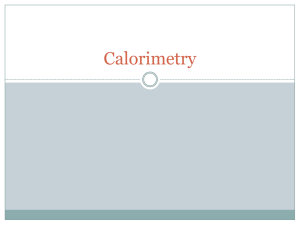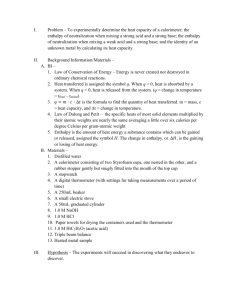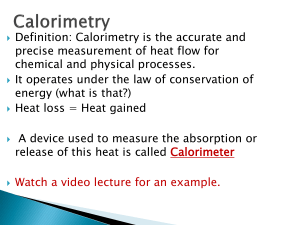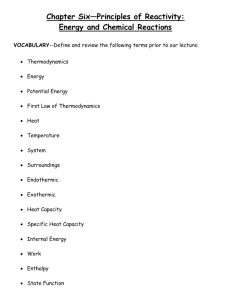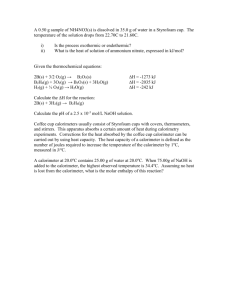Calorimetry Lab Report Problem – To experimentally determine the
advertisement
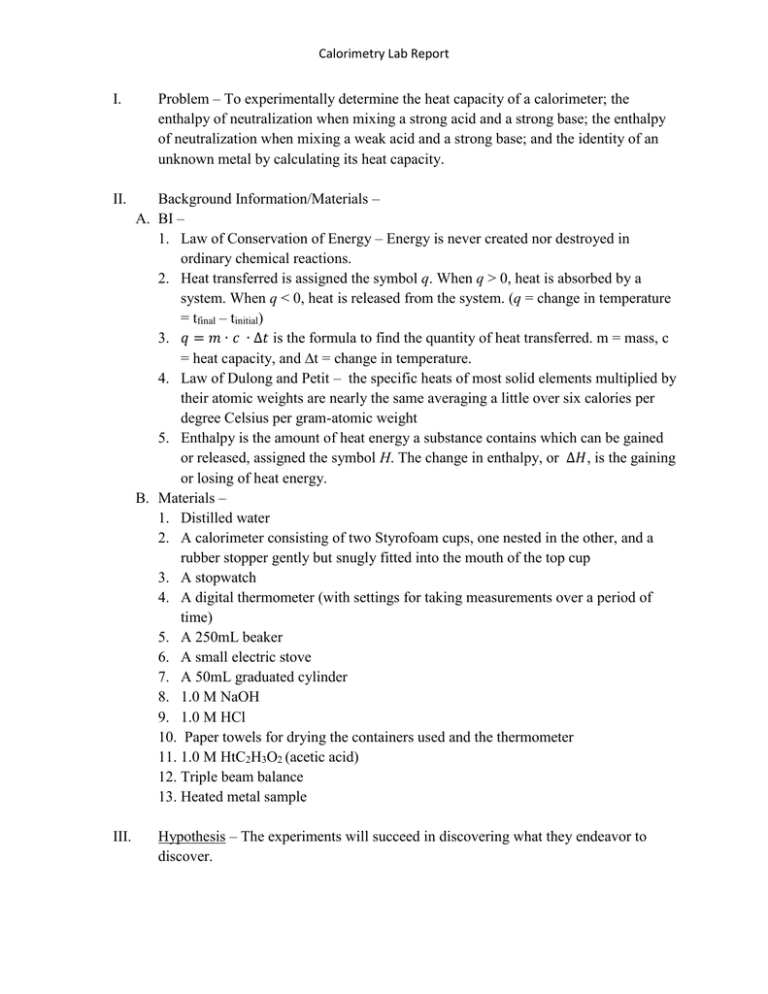
Calorimetry Lab Report I. Problem – To experimentally determine the heat capacity of a calorimeter; the enthalpy of neutralization when mixing a strong acid and a strong base; the enthalpy of neutralization when mixing a weak acid and a strong base; and the identity of an unknown metal by calculating its heat capacity. II. Background Information/Materials – A. BI – 1. Law of Conservation of Energy – Energy is never created nor destroyed in ordinary chemical reactions. 2. Heat transferred is assigned the symbol q. When q > 0, heat is absorbed by a system. When q < 0, heat is released from the system. (q = change in temperature = tfinal – tinitial) 3. 𝑞 = 𝑚 ∙ 𝑐 ∙ ∆𝑡 is the formula to find the quantity of heat transferred. m = mass, c = heat capacity, and ∆t = change in temperature. 4. Law of Dulong and Petit – the specific heats of most solid elements multiplied by their atomic weights are nearly the same averaging a little over six calories per degree Celsius per gram-atomic weight 5. Enthalpy is the amount of heat energy a substance contains which can be gained or released, assigned the symbol H. The change in enthalpy, or ∆𝐻, is the gaining or losing of heat energy. B. Materials – 1. Distilled water 2. A calorimeter consisting of two Styrofoam cups, one nested in the other, and a rubber stopper gently but snugly fitted into the mouth of the top cup 3. A stopwatch 4. A digital thermometer (with settings for taking measurements over a period of time) 5. A 250mL beaker 6. A small electric stove 7. A 50mL graduated cylinder 8. 1.0 M NaOH 9. 1.0 M HCl 10. Paper towels for drying the containers used and the thermometer 11. 1.0 M HtC2H3O2 (acetic acid) 12. Triple beam balance 13. Heated metal sample III. Hypothesis – The experiments will succeed in discovering what they endeavor to discover. Calorimetry Lab Report IV. A. B. C. D. Procedures – Heat capacity of the calorimeter 1. Gather materials. 2. Weigh your calorimeter using the triple beam balance. 3. Pour 50.0 mL distilled water in the calorimeter and replace the cover. 4. Allow the temperature to equilibrate for five minutes, and record the temperature (this is the initial temperature). 5. Place 50.0 mL water in a 250 mL beaker and heat until the temperature is about 15-20* above room temperature. 6. Set the beaker on the bench top for a minute, record the temperature and quickly pour the water into the calorimeter and replace the cover. 7. Record the temperature at 15 second intervals for three minutes. 8. When you have finished recording the data, empty and dry out your calorimeter. Enthalpy of neutralization of a strong acid and a strong base 1. Measure 50.0 mL 1.0 M NaOH into a graduated cylinder and pour it into your calorimeter. 2. Measure 50.0 mL 1.0 M HCl into another graduated cylinder. 3. Allow the temperature to equilibrate for several minutes, and record the temperature. 4. Wipe off the thermometer after measuring the temperature of each solution to ensure against any reaction taking place before you are ready. 5. When the temperatures of the NaOH and HCl solutions are identical, quickly pour the HCl into the NaOH and replace the cover. 6. Record the temperature at 15 second intervals for three minutes. 7. When you have finished recording the data, empty and dry out your calorimeter. Enthalpy of neutralization of a weak acid and a strong base 1. Repeat the procedures for part B, substituting 50.0 mL of 1.0 M acetic acid in place of HCl. 2. Record the data as above and, when completed, empty and dry out your calorimeter. Heat capacity of an unknown metal 1. Weigh your heated metal sample using the triple beam balance. 2. Pour 50.0 mL water into the calorimeter, and allow the temperature to equilibrate for 5 minutes and record the temperature (t = 0 sec). 3. Quickly pour the metal sample into the calorimeter, replace the cover, and record the temperature at 15 second intervals for three minutes. 4. When you have finished recording the data, empty and dry out your calorimeter. (Leave metal sample to air dry.) 5. Clean up. Calorimetry Lab Report V. Data – A. Part A Data – 1. ti cool water = 21.5 *C 2. ti warm water = 37.5 *C 3. seconds *C seconds 0 28.5 75 15 29.4 90 30 29.6 105 45 29.6 120 60 29.6 135 *C 29.6 29.6 29.5 29.5 29.5 seconds 150 165 180 *C 29.5 29.4 29.4 B. Part B Data 1. ti NaOH = 22.2 *C 2. ti HCl = 22.2 *C 3. Seconds *C 0 27.2 15 28.2 30 28.3 45 28.3 60 28.3 seconds 75 90 105 120 135 *C 28.2 28.2 28.2 28.1 28.1 seconds 150 165 180 *C 28.1 28.1 28.1 C. Part C Data 1. ti NaOH = 20.9 *C 2. ti acetic acid = 20.9 *C 3. seconds *C seconds 0 25.5 75 15 26.9 90 30 26.9 105 45 27.0 120 60 27.0 135 *C 27.0 26.9 26.9 26.9 26.9 seconds 150 165 180 *C 26.8 26.8 26.8 D. Part D Data 1. ti water = 22.1 *C 2. ti calorimeter = 22.1 *C 3. ti metal = 78.2 *C Calorimetry Lab Report 4. seconds 0 15 30 45 60 VI. *C 27.5 27.7 27.7 27.4 27.3 seconds 75 90 105 120 135 *C 27.2 27.2 27.1 27.1 27.1 seconds 150 165 180 *C 27.1 27.1 27.1 Conclusion – The experiments fulfilled their purpose and yielded useful data.


